Fiberglass Boat Restoration
Now Even Beginners Can Have Success!
Ask any boat owner about shine, and you'll get an enthusiastic response - everyone wants their boat gleaming like new.
Yet the mere thought of tackling oxidation can send even seasoned boaters running for the dock.
Here's the good news: thanks to modern tools and products, restoring your fiberglass boat's finish is no longer a job reserved for professionals.
With new technology in buffers featuring precise speed control and newly formulated compounds and polishes, what once took days of backbreaking work can now be accomplished quicker and easier.
Even if you've never attempted boat restoration before, you can successfully remove oxidation, eliminate surface imperfections, and bring back that showroom shine to your boat's gelcoat. The process is more approachable than ever - and the results will make you proud to show off your pride and joy on the water.
Fiberglass Boat Restoration:
Helping you to have a fighting chance!
Like every other area of life, the industry of auto detailing and boat detailing would bury you with information that is ultimately trying to separate you from as much of your money as possible.
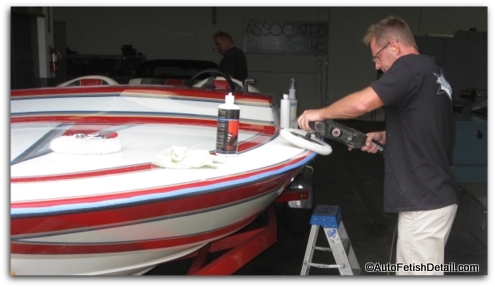
As a boat owner you basically have 3 choices:
- Do absolutely nothing
- Pay someone like myself a "boat" load of money to perform the fiberglass boat restoration (this requires lots of money and I don't live close enough to most people reading this)
- Or do it yourself -and yes, you really do have a fighting chance!
Fiberglass Boat Restoration:
Breaking it Down
While it is possible to polish your boat with one of the very popular dual-action, random orbital car buffers, if your goal is to produce professional results that also last, you will require the use of what is most commonly referred to as a high-speed polisher.
While there are entry level products to restore your
fiberglass boat using a boat cleaner wax and trying to remove the oxidation by hand, nothing compares to the results only achievable with a rotary polisher (high-speed polisher).
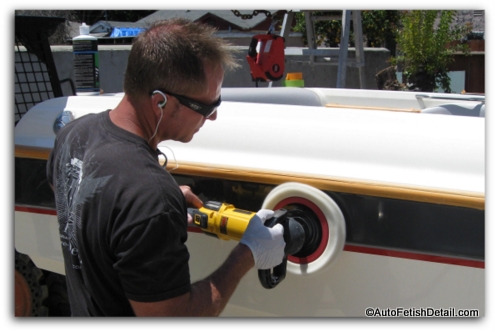
One thing I have learned along the way in my professional career is that virtually every boat owner severely underestimates what is required to actually remove the oxidation from a boat. Most boat owners think that a lot of rubbing with some top rated boat cleaner wax is going to be the fix.
While this will have the ability to make a visual difference, in most cases the results will not last and are simply insufficient for what is actually required to make a lasting difference.
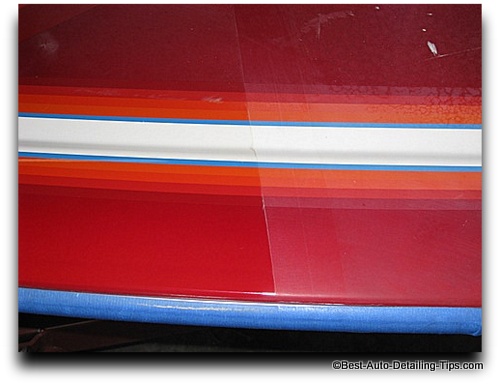
Which side wold you rather have your boat look like? This is a before and after shot after the gel coat was restored to original shine and luster using a high-speed buffer. I taped off the section at the right so it would go untouched during the restoration process that I did on the section on left. The rub-rail is still covered with blue painters tape I recommend for protection during the process. You would never get these kinds of results simply rubbing your boat out by hand!
Fiberglass Boat Oxidation Removal:
Your tools and products
Let's start out with your necessary tools and products you will need to polish your boat.
Equipment:
- Rotary Polisher (often referred to as a high-speed polisher or buffer)
- Wool Polishing Pads (I recommend equipping yourself with at least 4 pads for a 18-24 foot boat- nothing "cuts" like a new pad and you cannot go through too many of them)
- Pad Cleaning Spur (this is a unique tool designed to clean the wool pads during use)
- Microfiber Cloths (used to remove compound/polish as you are working)
Products:
- Compound/Polish (compound, polish, rubbing compound, polishing compound are all interchangeable terminology)
- Wax or Sealant (you will want to finish with a coat of wax or sealant for protection)
- Or yo may choose a product that is both a compound and wax.
Boat Polisher (Rotary)
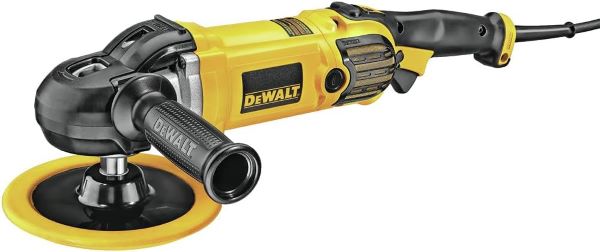
DeWalt Boat Polisher on Amazon
- A true workhorse at a very affordable price
- The exact buffer I use professionally when polishing the gelcoat/fiberglass on any boat
- Variable speed setting dial, along with speed control at trigger
- Different handles provide options for you as the user
Wool Buffing Pads
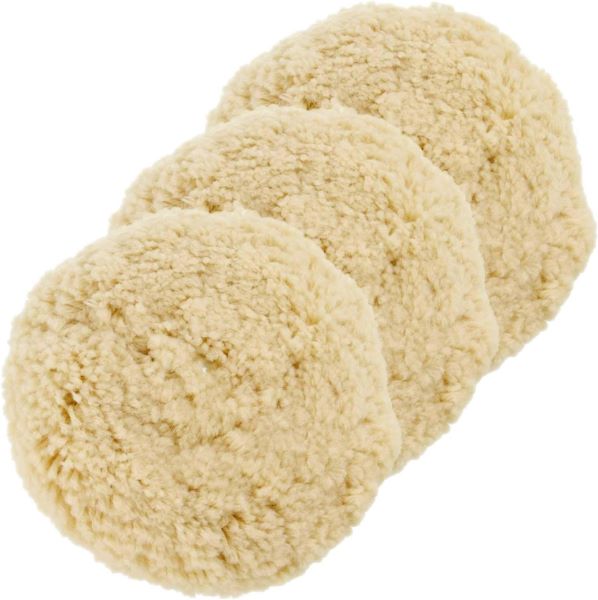
- 100% Wool (these cut better and last longer than synthetic blends)
- Hook and Loop attachment (Velcro backing that attaches instantly to backing plate)
Pad Cleaning Tool
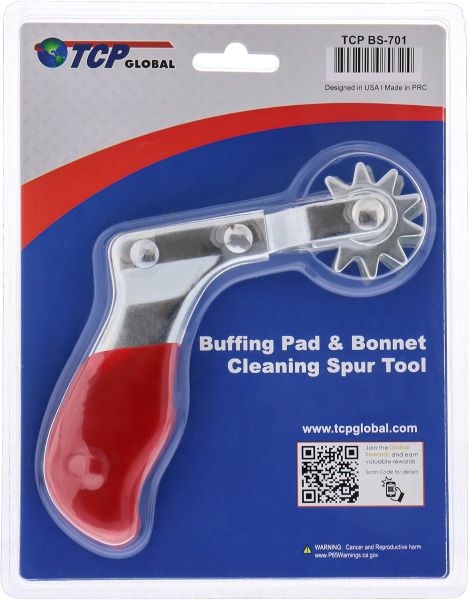
- You will need some type of tool to clean your pads during the buffing process (cheap-asses simply use a screw driver as a pad cleaning tool)
- The cleaning spur breaks up pad fibers and releases "spent" compound and oxidation build-up
- I generally use the cleaning spur after every (2) applications of compound (just a quick cleaning allows the pad from getting loaded up with compound and oxidation material)
Best Compound or Polish:
Fiberglass Boat Restoration
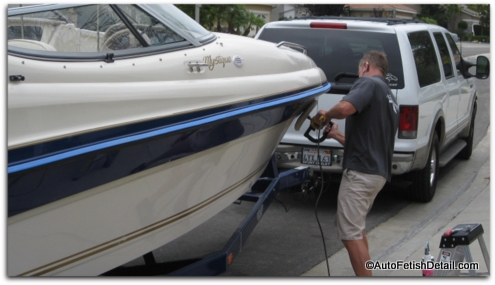
Most compounds or polishes offered at the retail level are simply too "mild" to prove effective for removing any level of boat oxidation.
The countless retail products in the form of compounds and polishes are "watered" down to make them "safe". Unfortunately this also makes them safe from producing desired results!
Once again...polishing a boat to remove oxidation is nothing like polishing car paint. Two completely different animals!
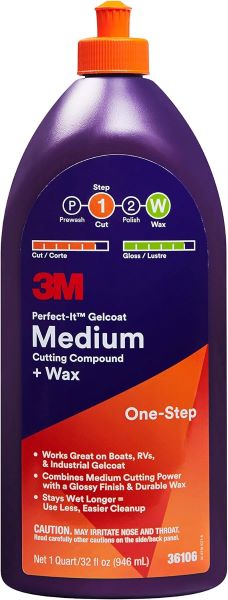
3M Medium Compound+Wax on Amazon
- Produced by one of the most recognized names (3M)
- Excellent user experience that also performs
- Capable of removing 1500 grit sanding marks (which also means capable of removing heavy oxidation)
- Also contains a wax so you can accomplish the gelcoat/fiberglass restoration while leaving a protective coating of wax
Darren's Note: If you know your boat has heavy oxidation, I would definitely recommend getting the "Heavy Cutting Compound" by 3M and then accept you will need to apply a separate boat wax after you have finished all the oxidation removal.
This Medium Cut version contains a wax so you accomplish both polishing and waxing at the same time.
Best Boat Wax
After you have performed your fiberglass boat restoration, you will naturally be faced with a quest to find the best boat wax for your fiberglass boat.
"The best marine wax will be the wax that makes it onto your boat more often rather than less often"
If you choose a wax that is so difficult to apply and remove, you will find that your "best boat wax" never makes it onto your boat and remains in the bottle.
This will do your boat no good!
For this reason I tell people that the best wax for your boat will be the wax you are willing to use more often.
And when it comes to fiberglass boat restoration, the last thing you want to have to do is go through all those polishing steps and then default to an inferior wax or sealant.
With that said....regardless of what you read or hear, no wax in the world is going to prevent your boat from oxidizing moving forward.
But a quality boat or marine wax will prevent the oxidation problem from happening sooner.
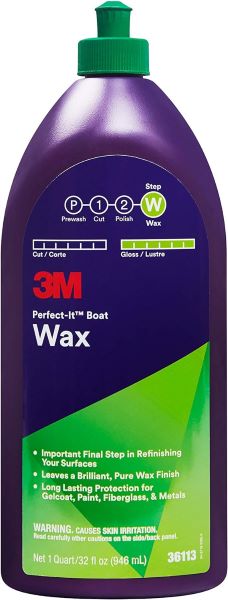
3M Perfect-it Boat Wax on Amazon
- Easier to use than paste wax products when it comes to waxing your fiberglass boat
- Formulated for marine use
- Safe for all materials on your boat: fiberglass, gel coat, painted boats, stainless steel components, plexiglass, etc.
Darren's Tips: One thing I have learned is that most boat owners do not understand just how quickly and easily your boat will oxidized (even boats kept in indoor storage) and underestimate how important it is to keep wax on your boat, and how important it is to apply this wax on a very frequent and consistent basis. You literally could NOT wax your boat too often or too much!!
Darren's Professional Tips for Fiberglass Boat Restoration
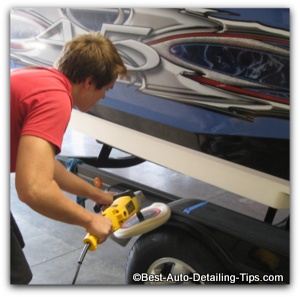
The picture at the right showing my 16 year old son using a high-speed buffer for the first time as he polishes the fender of the boat trailer. These buffers are so much more user friendly than previous generation polishers.
- It is common for people to make a comparison between car paint and working on gelcoat/fiberglass; fiberglass boat restoration will be far more aggressive and time consuming.
- Gelcoat/fiberglass is a very tough and durable material that is able to handle far more friction, heat, and aggressiveness than car paints.
- If you have ever polished on your car before, restoring gel coat or fiberglass will require far more product, pressure, and speeds for true professional results when it comes to heavy layers of oxidation.
- Use common blue painters tape to mask off any areas to protect from the buffer pad and sling from polish.
- For heavy levels of oxidation, it will not be uncommon for me to go over the same section 2-3 times before desired results are achieved.
- I use an RPM range between 1200-1500 RPM's when polishing on boats. Many guys will go as high as 1800-2100 RPM's.
- I apply approximately 10-15 pounds of pressure onto the buffer as I am working. (this is my best guess. The point is I apply substantial pressure as compared to that of car paint)
- If the oxidation is heavy; expect to go back over each section with multiple applications of compound.
- I apply the compound to the center of the pad rather than directly onto the boat. I use about a quarter (American quarter) size of compound for each section. This is usually enough to polish a 2 x 2 foot section of your fiberglass boat restoration area. (your needs will vary based on the severity of the oxidation - the more oxidation, ,the more compound you will need each time)
- I clean my pads after every 2 applications of product to keep my pads clean and the fibers separated.
Fiberglass Boat Restoration Conclusion
Thanks for visiting my website! I hope that by reading this page, you feel more confident in your ability to take on fiberglass boat restoration yourself.
You don’t need to pay a professional a boatload of money to have a beautiful, shiny boat!
While hand-polishing might seem like the easy way out, it simply won’t give you the lasting results you desire. You will want to invest in a high-speed polisher to tackle this job and make sure you’re using a compound that's tough enough to cut through heavy oxidation.
The sources and I agree that while this can be a multi-step process that takes some time, it’s worth it to see the gleaming results of your labor.
Happy polishing!
Sincerely,
Darren Priest
|
|

